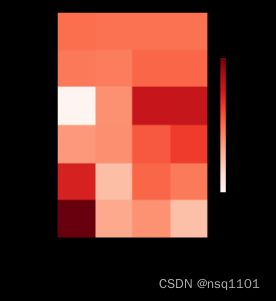10.4. Bahdanau 注意力
文章目录
-
- 10.4. Bahdanau 注意力
-
- 10.4.1. 模型
- 10.4.2. 定义注意力解码器
- 10.4.3. 训练
- 10.4.4. 小结
10.4. Bahdanau 注意力
Bahdanau等人提出了一个没有严格单向对齐限制的 可微注意力模型 [Bahdanau et al., 2014]。 在预测词元时,如果不是所有输入词元都相关,模型将仅对齐(或参与)输入序列中与当前预测相关的部分。这是通过将上下文变量视为注意力集中的输出来实现的。
10.4.1. 模型
一个带有Bahdanau注意力的循环神经网络编码器-解码器模型
import torch
from torch import nn
from d2l import torch as d2l
10.4.2. 定义注意力解码器
如何定义Bahdanau注意力,实现循环神经网络编码器-解码器。 其实,我们只需重新定义解码器即可。
为了更方便地显示学习的注意力权重, 以下AttentionDecoder类定义了带有注意力机制解码器的基本接口。
#@save
class AttentionDecoder(d2l.Decoder):
"""带有注意力机制解码器的基本接口"""
def __init__(self, **kwargs):
super(AttentionDecoder, self).__init__(**kwargs)
@property
def attention_weights(self):
raise NotImplementedError
接下来,让我们在接下来的Seq2SeqAttentionDecoder类中 实现带有Bahdanau注意力的循环神经网络解码器。 首先,我们初始化解码器的状态,需要下面的输入:
-
编码器在所有时间步的最终层隐状态,将作为注意力的键和值;
-
上一时间步的编码器全层隐状态,将作为初始化解码器的隐状态;
-
编码器有效长度(排除在注意力池中填充词元)。
在每个解码时间步骤中,解码器上一个时间步的最终层隐状态将用作查询。 因此,注意力输出和输入嵌入都连结为循环神经网络解码器的输入。
class Seq2SeqAttentionDecoder(AttentionDecoder):
def __init__(self, vocab_size, embed_size, num_hiddens, num_layers,
dropout=0, **kwargs):
super(Seq2SeqAttentionDecoder, self).__init__(**kwargs)
self.attention = d2l.AdditiveAttention(
num_hiddens, num_hiddens, num_hiddens, dropout)
self.embedding = nn.Embedding(vocab_size, embed_size)
self.rnn = nn.GRU(
embed_size + num_hiddens, num_hiddens, num_layers,
dropout=dropout)
self.dense = nn.Linear(num_hiddens, vocab_size)
def init_state(self, enc_outputs, enc_valid_lens, *args):
# outputs的形状为(batch_size,num_steps,num_hiddens).
# hidden_state的形状为(num_layers,batch_size,num_hiddens)
outputs, hidden_state = enc_outputs
return (outputs.permute(1, 0, 2), hidden_state, enc_valid_lens)
def forward(self, X, state):
# enc_outputs的形状为(batch_size,num_steps,num_hiddens).
# hidden_state的形状为(num_layers,batch_size,
# num_hiddens)
enc_outputs, hidden_state, enc_valid_lens = state
# 输出X的形状为(num_steps,batch_size,embed_size)
X = self.embedding(X).permute(1, 0, 2)
outputs, self._attention_weights = [], []
for x in X:
# query的形状为(batch_size,1,num_hiddens)
query = torch.unsqueeze(hidden_state[-1], dim=1)
# context的形状为(batch_size,1,num_hiddens)
context = self.attention(
query, enc_outputs, enc_outputs, enc_valid_lens)
# 在特征维度上连结
x = torch.cat((context, torch.unsqueeze(x, dim=1)), dim=-1)
# 将x变形为(1,batch_size,embed_size+num_hiddens)
out, hidden_state = self.rnn(x.permute(1, 0, 2), hidden_state)
outputs.append(out)
self._attention_weights.append(self.attention.attention_weights)
# 全连接层变换后,outputs的形状为
# (num_steps,batch_size,vocab_size)
outputs = self.dense(torch.cat(outputs, dim=0))
return outputs.permute(1, 0, 2), [enc_outputs, hidden_state,
enc_valid_lens]
@property
def attention_weights(self):
return self._attention_weights
# 接下来,我们使用包含7个时间步的4个序列输入的小批量测试Bahdanau注意力解码器。
encoder = d2l.Seq2SeqEncoder(vocab_size=10, embed_size=8, num_hiddens=16,
num_layers=2)
encoder.eval()
decoder = Seq2SeqAttentionDecoder(vocab_size=10, embed_size=8, num_hiddens=16,
num_layers=2)
decoder.eval()
X = torch.zeros((4, 7), dtype=torch.long) # (batch_size,num_steps)
state = decoder.init_state(encoder(X), None)
output, state = decoder(X, state)
output.shape, len(state), state[0].shape, len(state[1]), state[1][0].shape
# result
(torch.Size([4, 7, 10]), 3, torch.Size([4, 7, 16]), 2, torch.Size([4, 16]))
10.4.3. 训练
embed_size, num_hiddens, num_layers, dropout = 32, 32, 2, 0.1
batch_size, num_steps = 64, 10
lr, num_epochs, device = 0.005, 250, d2l.try_gpu()
train_iter, src_vocab, tgt_vocab = d2l.load_data_nmt(batch_size, num_steps)
encoder = d2l.Seq2SeqEncoder(
len(src_vocab), embed_size, num_hiddens, num_layers, dropout)
decoder = Seq2SeqAttentionDecoder(
len(tgt_vocab), embed_size, num_hiddens, num_layers, dropout)
net = d2l.EncoderDecoder(encoder, decoder)
d2l.train_seq2seq(net, train_iter, lr, num_epochs, tgt_vocab, device)
# result
loss 0.020, 5845.4 tokens/sec on cuda:0
模型训练后,我们用它将几个英语句子翻译成法语并计算它们的BLEU分数。
engs = ['go .', "i lost .", 'he\'s calm .', 'i\'m home .']
fras = ['va !', 'j\'ai perdu .', 'il est calme .', 'je suis chez moi .']
for eng, fra in zip(engs, fras):
translation, dec_attention_weight_seq = d2l.predict_seq2seq(
net, eng, src_vocab, tgt_vocab, num_steps, device, True)
print(f'{eng} => {translation}, ',
f'bleu {d2l.bleu(translation, fra, k=2):.3f}')
# result
go . => va !, bleu 1.000
i lost . => j'ai perdu ., bleu 1.000
he's calm . => je suis ici ., bleu 0.000
i'm home . => je suis chez moi ., bleu 1.000
attention_weights = torch.cat([step[0][0][0] for step in dec_attention_weight_seq], 0).reshape((
1, 1, -1, num_steps))
# 训练结束后,下面我们通过可视化注意力权重 你会发现,每个查询都会在键值对上分配不同的权重,这说明 在每个解码步中,输入序列的不同部分被选择性地聚集在注意力池
# 加上一个包含序列结束词元
d2l.show_heatmaps(
attention_weights[:, :, :, :len(engs[-1].split()) + 1].cpu(),
xlabel='Key positions', ylabel='Query positions')
10.4.4. 小结
- 在预测词元时,如果不是所有输入词元都是相关的,那么具有Bahdanau注意力的循环神经网络编码器-解码器会有选择地统计输入序列的不同部分。这是通过将上下文变量视为加性注意力池化的输出来实现的。
- 在循环神经网络编码器-解码器中,Bahdanau注意力将上一时间步的解码器隐状态视为查询,在所有时间步的编码器隐状态同时视为键和值。


